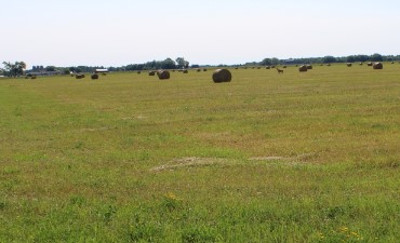By Jared Goplen
A lot of time and energy is spent putting up quality hay. All of that can be wasted without proper hay storage. Up to 50% losses in dry matter and quality can occur in some instances—the equivalent of leaving half of your hay acres unharvested. Prevent unnecessary hay losses this year by: 1) making dense bales of dry (<20%) hay, 2) stacking hay so it does not trap moisture, 3) improving drainage of your storage pad, and 4) considering buildings, tarps or bale wraps to keep hay covered. Even small changes can have large impacts on hay storage losses, forage quality, and profitability.
Hay has the same enemy in the field as it does in storage—moisture. Preventing moisture contact with bales should be top priority. Moisture enters hay from the top and bottom, coming from rainfall as well as wicking from the soil. Keeping hay off of the ground and under a covering structure prevents the majority of moisture problems. Hay properly stored should only lose 2-5% of dry matter over several years of storage. If hay gets wet, however, microbes come to life. Those microbes start eating away at the hay, which leads to losses in dry matter and deterioration in quality. The simultaneous loss of both dry matter and forage quality decreases hay value. In just 8 months, losses in forage quality can easily reduce hay value by more than $30 per ton.
Whether your hay is stored indoors or not, evaluate the ground your hay is stored on. If you are storing hay on poorly drained soil such as sod or black soil, water will wick up from the ground. Hay that is dry at harvest can increase to over 30% moisture through wicking. This level of moisture can cause spoilage and dry matter losses over 20% even over a short period of time. Losses may approach 50% if stored for more than one year. Storing hay on a well-drained surface such as gravel, rock, or old tires or pallets to keep hay out of contact with the soil should minimize dry matter losses to less than 15%.

If hay must be stored outside, a number of small changes can minimize storage losses. Square bales will be fine outside if you cover the bales and elevate them off the ground. Round bales are a better option if you do not cover the hay, as they shed water much better than square bales. Tightly rolled round bales shed water best. If you can push into the side of the bale less than a half inch, then the bale should be tight enough to shed water well. Net-wrapping improves the ability for bales to shed moisture, resulting in 32% less dry matter losses compared to twine bales. If twine is used, spacing it less than 6 inches apart will improve the bale’s ability to shed water.
Making larger bales means a greater percentage of the hay is protected inside the bale. The outer several inches of a bale tend to have the greatest spoilage, meaning larger bales help minimize storage losses outdoors. The outer 2 inches of a 4- foot bale contains 16% of the bale’s dry matter, while just 11% of dry matter is contained in the outer 2 inches of a 6-foot bale.
Another hay storage consideration is stacking method. Pyramid stacking of round bales should be avoided when left uncovered. This traps moisture and causes the largest dry matter losses. End to end stacking, so bale ends are touching, is the best choice for outdoor bale storage. Leaving 3-5 feet between rows of bales allows water a place to go and air movement between the bales. A north - south orientation of bales is best, as it permits more uniform sunlight to reach bales. This is especially the case if bales are stored through summer months.
If you need to preserve high quality hay and have little tolerance for losses, consider covering bales stored outside. Covering bales can reduce dry matter losses by an additional 6% or more compared to storing on a well-drained pad. Depending on the quality of hay, it could be well-worth the hassle and extra work of covering hay outside with plastic or tarps. Another option is to use one of the newer bale-covering technologies such as bale sleeves or bale wraps. These may be more realistic alternatives compared to covering with a tarp, and can minimize losses so they are more similar to that of indoor storage.
To minimize your hay storage losses—do everything you can to keep hay dry. Even small changes can minimize storage losses and allow you to preserve high-quality hay.